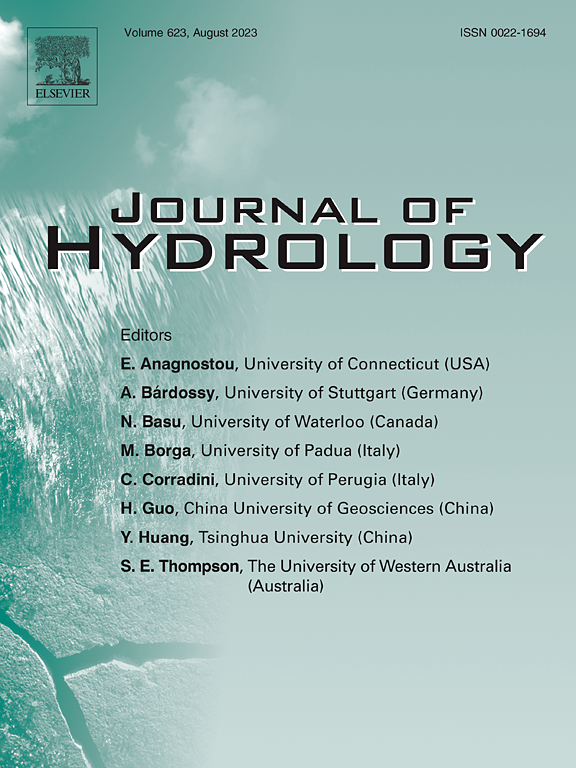Distinguishing salinization from desiccation induced salinity increases in shallow lakes affected by climate drying and land-use change
IF 5.9
1区 地球科学
Q1 ENGINEERING, CIVIL
引用次数: 0
Abstract
Global trends of increasing lake salinity stem from numerous mechanisms, including land use and climate change. As salinity varies inversely with water level in shallow lakes, the effects of a drying and warming climate can mimic salinization, the increased storage of dissolved salts. Even detecting trends in shallow lakes can be challenging due to large interannual variability. Here, I develop a new approach, based on a minimum of data, i.e. changing salinity–water level relationships, to identify and quantify salinization and disentangle mechanisms for rising salinity in warming and drying regions. The approach is applied to data from a long-term study of shallow lakes across south-west Australia, experiencing salinization due to land use change, and long-term climate drying and warming. Widespread desiccation or increasing salinity trends were found (58% of lakes), though only 18% of lakes had both trends. It is shown that 27% of the region’s lakes were salinizing and in these the average salt storage almost doubled in 20 years. Salinity trends are not reliable indicators of changing salt storage in shallow lakes. Salinity–water level relationships offer a physical basis with which to interpret changing lake hydrology, salinity and salinization in shallow lakes, even with poorly gauged inflows and outflows and an absence of bathymetry data. The approach gives new means to inform the conservation of shallow lake systems to maintain ecosystem services and aquatic biodiversity.
在受气候干燥和土地利用变化影响的浅湖中,区分盐渍化和干燥导致盐度增加
湖泊盐度增加的全球趋势源于多种机制,包括土地利用和气候变化。由于浅湖的盐度与水位成反比,干燥和变暖的气候可以模拟盐碱化,即溶解盐的储存增加。由于年际变化很大,即使探测浅湖的趋势也具有挑战性。在这里,我开发了一种新的方法,基于最小的数据,即变化的盐度-水位关系,来识别和量化盐碱化,并解开温暖和干燥地区盐度上升的机制。该方法应用于对澳大利亚西南部浅湖的长期研究数据,这些浅湖由于土地利用变化和长期气候干燥和变暖而经历了盐碱化。发现了广泛的干燥或盐度增加的趋势(58%的湖泊),尽管只有18%的湖泊同时具有这两种趋势。研究表明,该地区27%的湖泊正在盐渍化,这些湖泊的平均储盐量在20年内几乎翻了一番。盐度趋势并不是浅水湖泊盐储量变化的可靠指标。盐度-水位关系提供了一个物理基础,用以解释变化的湖泊水文、浅湖的盐度和盐碱化,即使在流入和流出测量不准确和缺乏测深数据的情况下也是如此。该方法为浅湖系统保护提供了新的手段,以维持生态系统服务和水生生物多样性。
本文章由计算机程序翻译,如有差异,请以英文原文为准。
求助全文
约1分钟内获得全文
求助全文
来源期刊

Journal of Hydrology
地学-地球科学综合
CiteScore
11.00
自引率
12.50%
发文量
1309
审稿时长
7.5 months
期刊介绍:
The Journal of Hydrology publishes original research papers and comprehensive reviews in all the subfields of the hydrological sciences including water based management and policy issues that impact on economics and society. These comprise, but are not limited to the physical, chemical, biogeochemical, stochastic and systems aspects of surface and groundwater hydrology, hydrometeorology and hydrogeology. Relevant topics incorporating the insights and methodologies of disciplines such as climatology, water resource systems, hydraulics, agrohydrology, geomorphology, soil science, instrumentation and remote sensing, civil and environmental engineering are included. Social science perspectives on hydrological problems such as resource and ecological economics, environmental sociology, psychology and behavioural science, management and policy analysis are also invited. Multi-and interdisciplinary analyses of hydrological problems are within scope. The science published in the Journal of Hydrology is relevant to catchment scales rather than exclusively to a local scale or site.
 求助内容:
求助内容: 应助结果提醒方式:
应助结果提醒方式:


